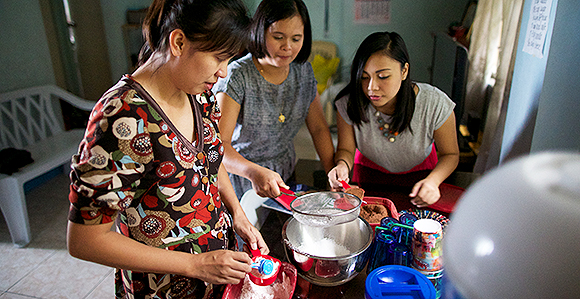Learning How to Minister: Relief Society Leaders Explain Changes to Visiting Teaching
Contributed By Marianne Holman Prescott, Church News staff writer

Filipino visiting teachers bake cupcakes with a sister they visit.
Article Highlights
- Visiting teachers are to get to know their sisters, strengthen their faith, and provide service.
- The focus of visiting teaching should be on ministering to the individual as Jesus Christ did.
- Visiting teachers should personalize the message they share with their sisters.
“We want to help sisters understand how to really care for and strengthen each sister.” —Jean B. Bingham, Relief Society General President
Beginning January 2018, changes to the monthly visiting teaching message will help sisters “minister” to each other in a more personal way. Rather than providing a specific message, each month a “Visiting Teaching Principle” will provide ideas to help sisters minister more effectively to each other.
“We want to help sisters understand how to really care for and strengthen each sister,” Sister Jean B. Bingham, Relief Society General President told the Church News. “The [Church] handbook doesn’t talk about our responsibilities to teach a lesson. It talks about how ‘visiting teachers sincerely come to know and love each sister, help her strengthen her faith and give service. [Visiting teachers] seek personal inspiration to know how to respond to the spiritual and temporal needs of each sister they are assigned to visit’ [Handbook 2, 9.5.1].”
The changes are meant to help visiting teachers look beyond a universal prepared message and figure out what the sister they visit personally needs.
“What are we supposed to do?” asked Sister Sharon Eubank, First Counselor in the Relief Society General Presidency. “Do what she needs.”
The new format will encourage women in the Church to stop worrying about “what counts” for visiting teaching and will share ideas to help visiting teachers focus on strengthening each woman they visit.
“Since each one of us is unique, each sister will need something different,” Sister Bingham said. “In [Handbook 2], it says ‘phone calls, letters, email, or other means to watch over and strengthen sisters’ are appropriate ways to find out their needs and help them. That’s the focus—we want to make sure that we are strengthening sisters in the gospel and each sister feels valued, needed, and included.”
Effective visiting teaching can be as simple as listening with love, as Sister Reyna I. Aburto, Second Counselor in the Relief Society General Presidency, noted. “About two weeks after I was sustained in my calling, I went to the home of one of the sisters I visit. As she opened the door, she gave me a big hug, and asked me how I was doing. Feeling the sincerity of her question and her love for me, I broke down in tears as I shared how inadequate I felt. She allowed me to cry on her shoulder and lovingly listened to me as I let out the emotions that I had been holding inside. I came to see how I could strengthen her, but she strengthened me.”
“We want sisters to have that same understanding,” Sister Bingham said. “Visiting teaching is genuine caring; it is compassionate service. It is making the bishop and the Relief Society president aware of the needs of the sisters that they visit.”
Recognizing that a spiritual message is important, Sister Bingham said visiting teachers should look for messages catered to the women that they visit.
“It can be [a quote] from the First Presidency, it could be from something you read in your scriptures, it can be something that you know this particular sister has an interest in,” she said. “It should be for that sister. What does she need?”

Rebekah Lowe, center, whose new baby was in the hospital, greets her visiting teacher, Jaime Johnson, of the San Clemente California Stake, USA. Sister Johnson, accompanied by her two sons, picked up Sister Lowe’s son so her friend could go to the hospital.
Sister Eubank added that there are many ways visiting teachers can minister. “‘Do what she needs’ is the essence of visiting teaching—an hour spent listening, a text at the right time, a walk, a scripture, a seat saved at church, pulling a few weeds in the garden while the kids run around—these are all valid ways to visit teach if they meet a sincere need. The book of Alma shines some insight on our baptismal covenant as the people of that time promised to ‘bear one another’s burdens, that they may be light’ [Mosiah 18:8]. Strengthening others is evidence of our conversion to the Lord,” Sister Eubank concluded.
By looking to the needs of the individual, visiting teachers are able to “avoid the mentality of visiting teaching being like a checklist [where] you come and give a message and 15 minutes later you leave and it is done,” said Sister Aburto.
For some women, a visit to their home or a phone call might be the best way to minister to them. For others, sending a text or email offering encouragement might be the best thing for that month.
The early practice of ministering visits started not long after the Relief Society was established in 1842. As the population of Nauvoo, Illinois, was expanding, Relief Society leaders began to use visiting committees to assess the needs of the members and gather donations of money, food, and clothing to provide aid and relief to the needy.
Although the details of the process have changed since those early days, the principles remain the same—to minister as the Savior would minister.
“Following His example, as visiting teachers we can come to know and love each sister we visit, remembering that love is the foundation of all we do,” it reads in the January 2018 message. “When we pray for inspiration to know how to serve her and help her strengthen her faith, ‘the angels cannot be restrained from being [our] associates.’”
“Making personal connections and listening with an attitude of love is the essence of visiting teaching,” the January 2018 message reads. “Modern technology and time-honored face-to-face visits help us do it anytime, anywhere, and in many ways. That is ministering as Jesus did.”
